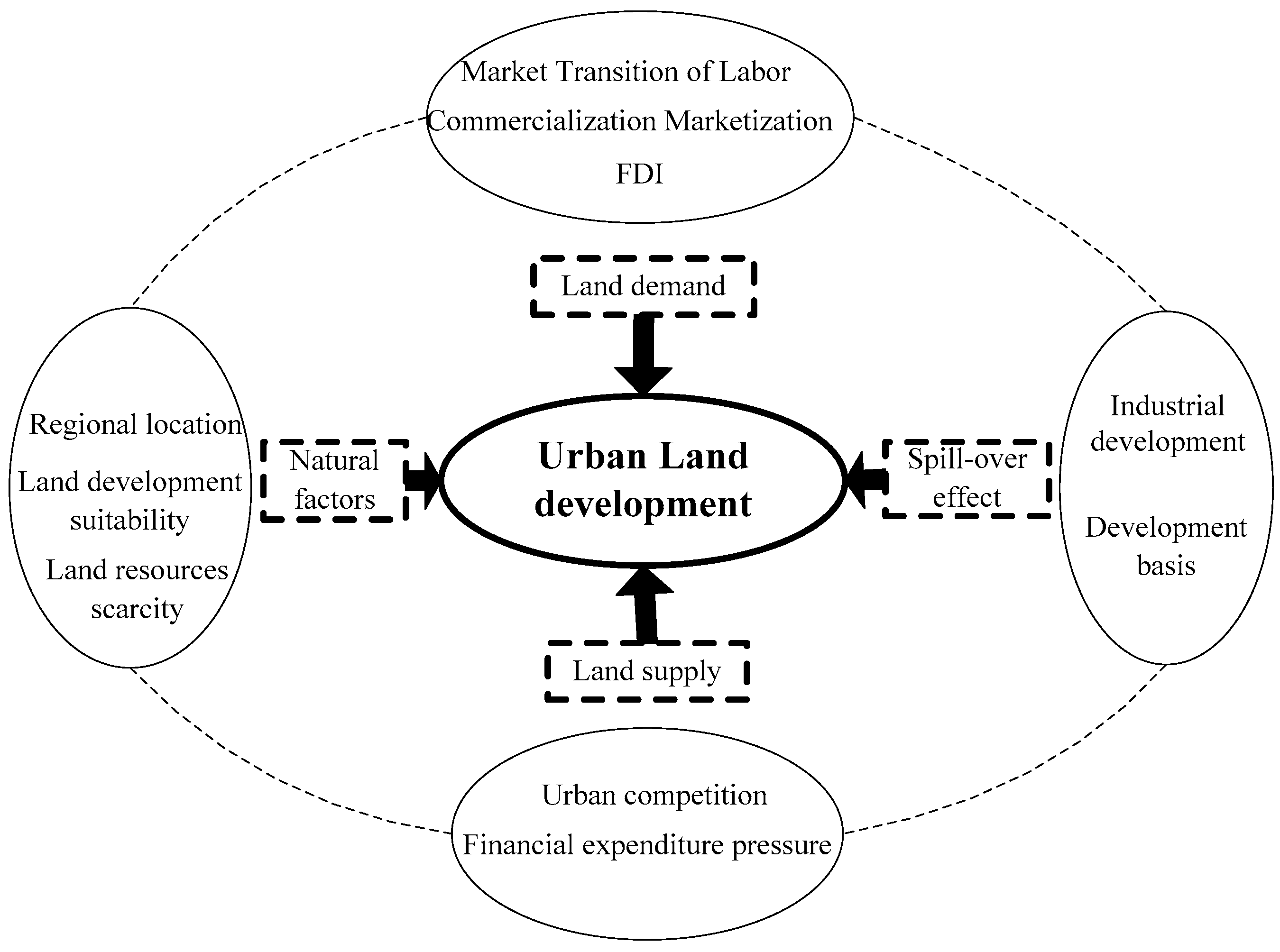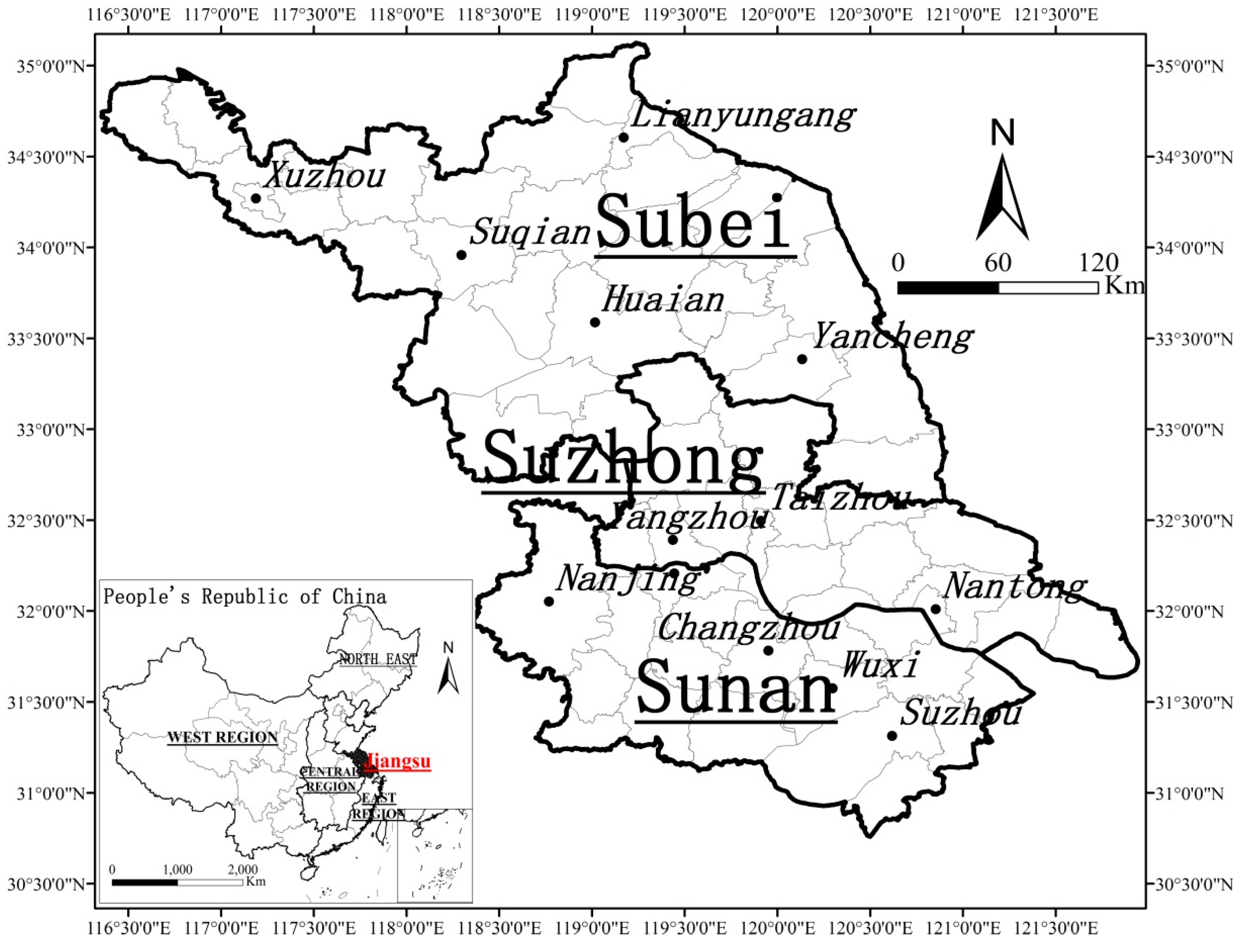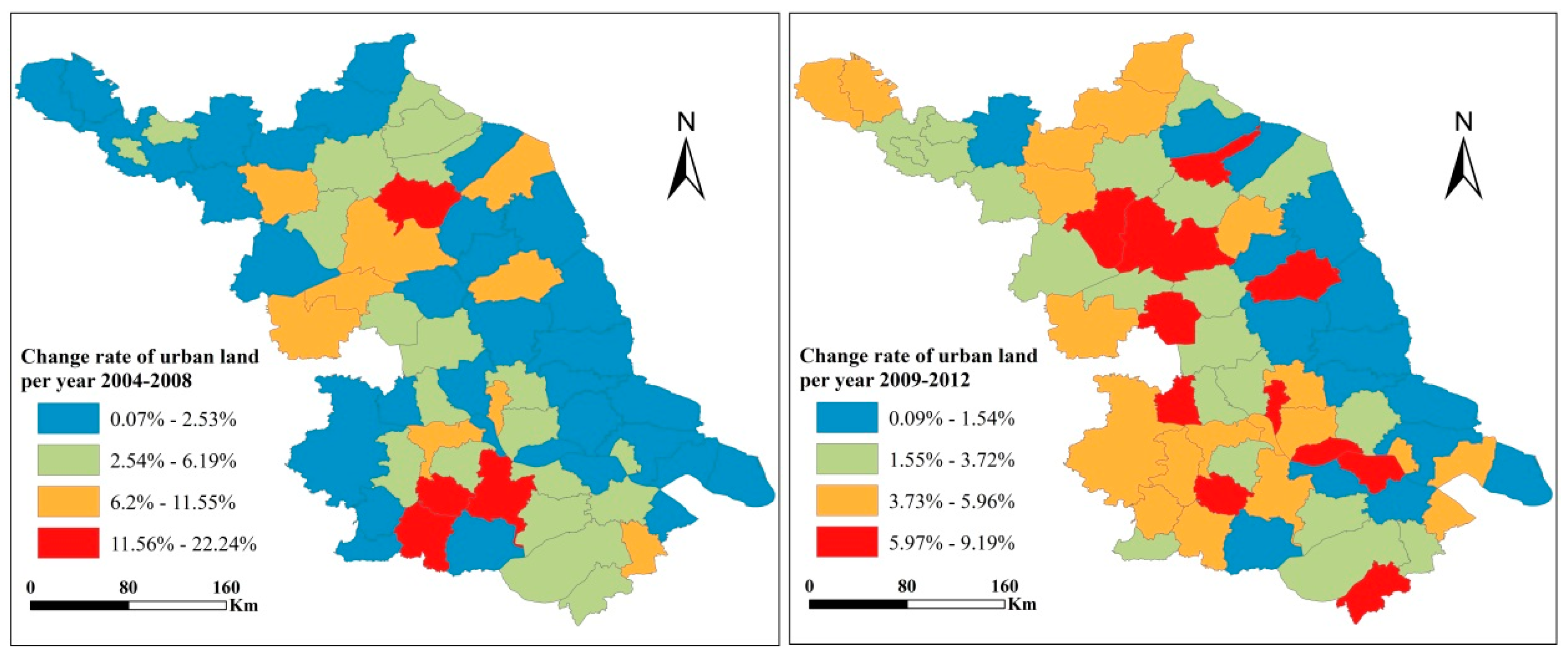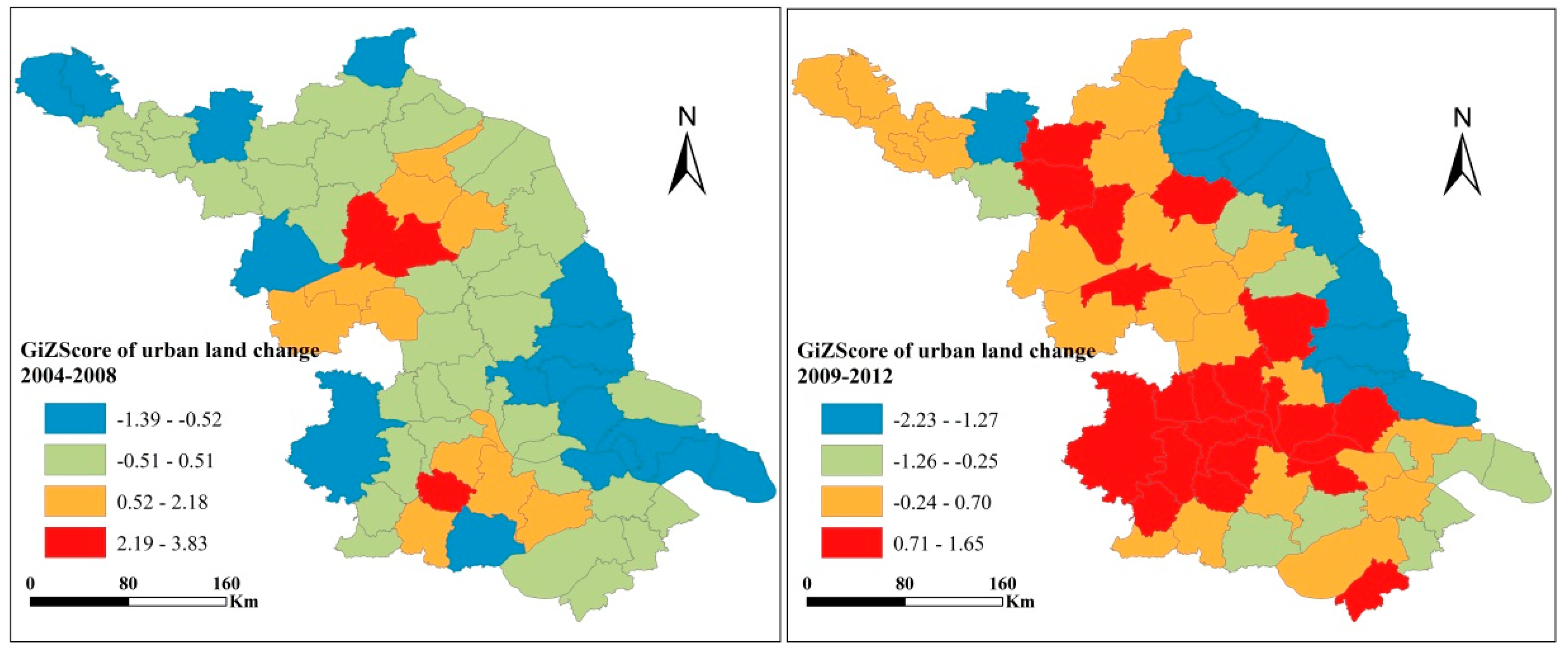Spatial–Temporal Patterns and Driving Factors of Rapid Urban Land Development in Provincial China: A Case Study of Jiangsu
Abstract
:1. Introduction
2. Understanding the Dynamics of Urban Land Development in China
2.1. Land Demand Factors
2.2. Land Supply Factors
2.3. Spill-Over Factors
2.4. Natural Factors
3. Study Area and Data Collection
4. Changing Patterns of Urban Land Development in Jiangsu Province
5. Urban Land Development Restructuring: Spatial Auto-Correlation Analysis
6. Driving Factors of Urban Land Development: Market Mechanisms and Local Government Initiatives
6.1. Model Specifications and Selection of Variables
6.2. Results of the Regression Analysis
7. Conclusions
Acknowledgments
Author Contributions
Conflicts of Interest
References
- Bai, X.M.; Shi, P.J.; Liu, Y.S. Realizing China’s urban dream. Nature 2014, 509, 158–160. [Google Scholar] [CrossRef] [PubMed]
- Chan, K.W. Crossing the 50 Percent Population Rubicon: Can China Urbanize to Prosperity? Eurasian Geogr. Econ. 2012, 53, 63–86. [Google Scholar] [CrossRef]
- Ma, L.J.C. Urban transformation in China, 1949–2000: A review and research agenda. Environ. Plan. A 2002, 34, 1545–1569. [Google Scholar] [CrossRef]
- Shen, J.F.; Wong, K.Y.; Feng, Z.Q. State-sponsored and spontaneous urbanization in the Pearl River Delta of south China, 1980–1998. Urban Geogr. 2002, 23, 674–694. [Google Scholar] [CrossRef]
- Zhou, Y.X.; Ma, L.J.C. China’s urbanization levels: Reconstructing a baseline from the fifth population census. China Q. 2003, 173, 176–196. [Google Scholar]
- Pannell, C.W. China’s continuing urban transition. Environ. Plan. A 2002, 34, 1571–1589. [Google Scholar] [CrossRef]
- Parker, R.A. Patterns of Federal Urban Spending Central Cities and their Suburbs, 1983–1992. Urban Aff. Rev. 1995, 31, 184–205. [Google Scholar] [CrossRef]
- Luo, J.; Wei, Y.H.D. Modeling spatial variations of urban growth patterns in Chinese cities: The case of Nanjing. Landsc. Urban Plan. 2009, 91, 51–64. [Google Scholar] [CrossRef]
- Shu, B.; Zhang, H.; Li, Y.; Qu, Y.; Chen, L. Spatiotemporal variation analysis of driving forces of urban land spatial expansion using logistic regression: A case study of port towns in Taicang City, China. Habitat Int. 2014, 43, 181–190. [Google Scholar] [CrossRef]
- He, C.; Huang, Z.; Wang, R. Land use change and economic growth in urban China: A structural equation analysis. Urban Stud. 2014, 51, 2880–2898. [Google Scholar] [CrossRef]
- Liao, F.H.F.; Wei, Y.H.D. Modeling determinants of urban growth in Dongguan, China: A spatial logistic approach. Stoch. Environ. Res. Risk Assess. 2014, 28, 801–816. [Google Scholar] [CrossRef]
- Verburg, P.H.; van de Steeg, J.; Veldkamp, A.; Willemen, L. From land cover change to land function dynamics: A major challenge to improve land characterization. J. Environ. Manag. 2009, 90, 1327–1335. [Google Scholar] [CrossRef] [PubMed]
- Song, K.; Liu, D.; Wang, Z.; Zhang, B.; Jin, C.; Li, F.; Liu, H. Land Use Change in Sanjiang Plain and Its Driving Forces Analysis since 1954. Acta Geogr. Sin. 2008, 63, 93–104. [Google Scholar]
- Liu, T.; Cao, G. Progress in Urban Land Expansion and Its Driving Forces. Prog. Geogr. 2010, 29, 927–934. [Google Scholar]
- Kong, X.; Zhang, F.; Li, Y.; Jiang, Y.; Yan, G.; Xu, Y. Interactive Relationship between Land Use Change and Industrial Change. Resour. Sci. 2005, 27, 59–64. [Google Scholar]
- Shi, P.J.; Chen, J.; Pan, Y.Z. Land use Change Mechanism in Shenzhen City. Acta Geogr. Sin. 2000, 55, 151–160. [Google Scholar]
- Bai, W.; Zhang, Y. Role of traditional cultural factors in land use changes in the Qinghai-Tibet Plateau. Resour. Sci. 2002, 24, 11–15. [Google Scholar]
- Liu, S.Y.; Jiang, X.S. Financial Risks of Land Financing by Local Governments—Case Study of a Developed Area in East China. China Land Sci. 2005, 19, 3–9. [Google Scholar]
- Jiang, L.; Deng, X.; Seto, K.C. Multi-level modeling of urban expansion and cultivated land conversion for urban hotspot counties in China. Landsc. Urban Plan. 2012, 108, 131–139. [Google Scholar] [CrossRef]
- Yew, C.P. Explaining Land Use Change in a Guangdong County: The Supply Side of the Story. China Q. 2011, 207, 626–648. [Google Scholar]
- Cartier, C. ‘Zone Fever’, the Arable Land Debate, and Real Estate Speculation: China’s evolving land use regime and its geographical contradictions. J. Contemp. China 2001, 10, 445–469. [Google Scholar] [CrossRef]
- Han, S.S. Urban expansion in contemporary China: What can we learn from a small town? Land Use Policy 2010, 27, 780–787. [Google Scholar] [CrossRef]
- Yang, D.Y.-R.; Wang, H.-K. Dilemmas of local governance under the development zone fever in China: A case study of the Suzhou region. Urban Stud. 2008, 45, 1037–1054. [Google Scholar] [CrossRef]
- Lin, G.C.S.; Ho, S.P.S. The state, land system, and land development processes in contemporary China. Ann. Assoc. Am. Geogr. 2005, 95, 411–436. [Google Scholar] [CrossRef]
- Liu, J. Spatio-Temporal Patterns and Driving Forces of Urban Land Expansion in China during the Economic Reform Era. AMBIO J. Hum. Environ. 2005, 34, 450–455. [Google Scholar] [CrossRef]
- Tao, R.; Su, F.; Liu, M.; Cao, G. Land Leasing and Local Public Finance in China’s Regional Development: Evidence from Prefecture-level Cities. Urban Stud. 2010, 47, 2217–2236. [Google Scholar]
- He, C.; Zhou, Y.; Huang, Z. Fiscal decentralization, political centralization, and urban land development in China. Urban Geogr. 2015, 37, 436–457. [Google Scholar] [CrossRef]
- Lin, G.C.S. Reproducing spaces of chinese urbanisation: New city-based and land-centred urban transformation. Urban Stud. 2007, 44, 1827–1855. [Google Scholar] [CrossRef]
- Gao, J.; Wei, Y.D.; Chen, W.; Yenneti, K. Urban Land Expansion and Structural Change in the Yangtze River Delta, China. Sustainability 2015, 7, 10281–10307. [Google Scholar] [CrossRef]
- Huang, Z.; Wei, Y.D.; He, C.; Li, H. Urban land expansion under economic transition in China: A multi-level modeling analysis. Habitat Int. 2015, 47, 69–82. [Google Scholar] [CrossRef]
- Zhu, J.M. A transitional institution for the emerging land market in urban China. Urban Stud. 2005, 42, 1369–1390. [Google Scholar] [CrossRef]
- Wu, W. Urban Infrastructure Financing and Economic Performance in China. Urban Geogr. 2010, 31, 648–667. [Google Scholar] [CrossRef]
- Zhu, J. Local developmental state and order in China’s urban development during transition. Int. J. Urban Reg. Res. 2004, 28, 424–447. [Google Scholar] [CrossRef]
- Li, H.B.; Zhou, L.A. Political turnover and economic performance: The incentive role of personnel control in China. J. Public Econ. 2005, 89, 1743–1762. [Google Scholar] [CrossRef]
- Lin, G.C.S.; Yi, F. Urbanization of Capital or Capitalization on Urban Land? Land Development and Local Public Finance in Urbanizing China. Urban Geogr. 2011, 32, 50–79. [Google Scholar] [CrossRef]
- Jia, P.; Yang, G. An Analysis of Driving Forces of Urban Land Expansion—A Case Study of Hubei Province. Res. Soil Water Conserv. 2006, 13, 182–185. [Google Scholar]
- Gu, C.L.; Yu, T.F.; Li, W.M. China’s Urbanization: Structure, Process, Mechanism; Science Press: Beijing, China, 2009; pp. 543–550. [Google Scholar]
- Deng, X.; Huang, J.; Rozelle, S.; Uchida, E. Growth, population and industrialization, and urban land expansion of China. J. Urban Econ. 2008, 63, 96–115. [Google Scholar] [CrossRef]
- Chen, J.; Chang, K.-T.; Karacsonyi, D.; Zhang, X. Comparing urban land expansion and its driving factors in Shenzhen and Dongguan, China. Habitat Int. 2014, 43, 61–71. [Google Scholar] [CrossRef]
- Yang, R.N.; Zhang, X.L. A Study on the Impetus Mechanism and Models of Urban Spatial Expansion. Areal Res. Dev. 1997, 16, 1–4. [Google Scholar]
- Ding, X.Z.; Liu, S.Z. The Geomorphological Factors of Influence on Urban Distribution and Construction in China. J. Southwest Teach. Univ. 1990, 15, 453–461. [Google Scholar]
- Li, Z.; Lei, J.; Li, X.; Gao, C. The Features and Influencing Factors of Urban Expansion in China during 1997–2007. Prog. Geogr. 2011, 30, 607–614. [Google Scholar]
- Oi, J.C. Rural China Takes off: Institutional Foundations of Economic Reform; Springer: Berlin, Germany, 1999; pp. 1215–1217. [Google Scholar]
- Wang, L.; Wong, C.; Duan, X. Urban growth and spatial restructuring patterns: The case of Yangtze River Delta Region, China. Environ. Plan. B 2016, 43, 515–539. [Google Scholar] [CrossRef]
- Wei, Y.D.; Fan, C.C. Regional Inequality in China: A Case Study of Jiangsu Province. Prof. Geogr. 2000, 52, 455–469. [Google Scholar] [CrossRef]
- Gao, J.; Wei, Y.D.; Chen, W.; Chen, J. Economic transition and urban land expansion in Provincial China. Habitat Int. 2014, 44, 461–473. [Google Scholar] [CrossRef]
- Bureau of Statistics of Jiangsu Province. Jiangsu Statistical Yearbook (2005–2013); China Statistics Press: Beijing, China, 2013.




| Prefecture Cities | 2004–2008 | 2009–2012 |
|---|---|---|
| Total (Annual) Percentage | Percentage Increase | |
| Jiangsu | 9.43 (4.53%) | 23.35 (3.92%) |
| Sunan | 6.02 (5.35%) | 13.16 (4.02%) |
| Nanjing | 0.18 (0.67%) | 3.22 (4.62%) |
| Wuxi | 0.43 (1.99%) | 1.12 (1.92%) |
| Suzhou | 2.03 (5.67%) | 5.25 (4.24%) |
| Changzhou | 3.01 (3.93%) | 2.01 (4.38%) |
| Zhenjiang | 0.37 (3.48%) | 1.56 (5.18%) |
| Suzhong | 0.94 (2.78%) | 3.49 (3.51%) |
| Nantong | 0.33 (2.5%) | 1.05 (2.74%) |
| Taizhou | 0.25 (3.52%) | 1.31 (4.64%) |
| Yangzhou | 0.36 (2.66%) | 1.13 (3.44%) |
| Subei | 2.47 (4.02%) | 6.7 (3.97%) |
| Xuzhou | 0.31 (1.58%) | 1.55 (3.27%) |
| Lianyungang | 0.38 (3.84%) | 1.01 (3.14%) |
| Huai’an | 0.94 (5.93%) | 1.73 (3.92%) |
| Yancheng | 0.43 (2.58%) | 1.23 (3.51%) |
| Suqian | 0.41 (6.01%) | 1.19 (4.75%) |
| Change Rate | 2004–2008 | 2009–2012 | ||||
|---|---|---|---|---|---|---|
| General G | Z-Score | p-Value | General G | Z-Score | p-Value | |
| Urban land | 3.32 × 10−2 | 28.93 | 0.000 | 3.02 × 10−2 | 21.76 | 0.000 |
| Categories | Variables | Abbreviation | Definition and Measurement | Expected Sign |
|---|---|---|---|---|
| Independent variable | Change of urban land | URL | Measured by the absolute change of urban land area | |
| Land demand factors | Labor marketization | MTL | Measured by the ratio of employment in the non-state sector | + |
| Production marketization | MC | Measured by the ratio of output value in non-state-owned industries | + | |
| Strength of foreign direct investment | FDI | Measured by the ratio of realized FDI to GDP in a particular time interval | + | |
| Level of international trade | LIT | Measured by the ratio of total amount of output value of import and export to GDP in a particular time interval | + | |
| Land supply factors | Power of local governments | GC | Calculated by the average economic development (GDP corrected by the consumer price index), which is weighted by the administrative level (county-level city = 1.2; county = 1; municipal district = 0.8) | + |
| Financial constraints | LF | Calculated by the proportion of tax revenue to the general budget expenditure | + | |
| Spill-over factors | GDP per capital | PGDP | Represented as the level of regional economic development | + |
| Index of industrial structure advancement | IAIS | Represented as the development of the industrial structure from a low to high level | + | |
| Natural factors | Suitability of land development | SLD | Measured by equal weighting summation of the indices of natural disaster risk, ecological importance, water environmental capacity, and abundance | + |
| Land location | RL | Measured by local factors of accessibility (e.g., distance to Shanghai) and level of regional development | + | |
| The scarcity of land resources | SLR | Represented as the per capita arable land that can be used as the measured index, and the higher the value, the lower the resistance to land development | − |
| URL | MTL | MC | FDI | LIT | GC | LF | PGDP | IAIS | SLD | RL | SLR | |
|---|---|---|---|---|---|---|---|---|---|---|---|---|
| URL | 1.00 | |||||||||||
| MTL | 0.28 ** | 1.00 | ||||||||||
| MC | 0.15 ** | 0.03 | 1.00 | |||||||||
| FDI | 0.12 | 0.22 ** | −0.11 | 1.00 | ||||||||
| LIT | 0.28 ** | 0.448 ** | −0.16 ** | 0.44 ** | 1.00 | |||||||
| GC | 0.12 | 0.05 | −0.17 * | 0.02 | 0.13 | 1.00 | ||||||
| LF | −0.31 ** | −0.52 ** | 0.12 * | −0.36 ** | −0.67 ** | −0.11 | 1.00 | |||||
| PGDP | 0.38 ** | 0.68 ** | −0.09 | 0.25 ** | 0.52 ** | 0.11 | −0.67 ** | 1.00 | ||||
| IAIS | 0.42 ** | 0.54 ** | −0.17 ** | 0.26 ** | 0.57 ** | 0.17 * | −0.68 ** | 0.71 ** | 1.00 | |||
| SLD | 0.07 | 0.31 ** | −0.11 | 0.28 ** | 0.35 ** | 0.06 | −0.35 ** | 0.30 ** | 0.26 ** | 1.00 | ||
| RL | 0.10 ** | −0.29 ** | 0.10 | −0.21 ** | −0.50 ** | −0.13 | 0.49 ** | −0.39 ** | −0.53 ** | −0.16 ** | 1.00 | |
| SLR | −0.31 | 0.32 ** | 0.11 | 0.17 ** | 0.01 | −0.02 | −0.03 | 0.27 ** | 0.13 * | 0.04 | 0.15 * | 1.00 |
| Variable | 2004–2008 | 2009–2012 | ||||
|---|---|---|---|---|---|---|
| Model 1 | Model 2 | Model 3 | Model 1 | Model 2 | Model 3 | |
| W_URL | 0.176 | 0.209 * | 0.122 | 0.15 * | −0.031 | 0.041 |
| CONSTANT | 0.074 | 0.056 | −0.036 | 0.188 | −0.072 | 0.07 |
| MTL | 0.035 | 0.028 | 0.032 | −0.01 | −0.041 * | −0.015 |
| MC | 0.009 | 0.07 * | 0.069 * | −0.224 *** | −0.04 | −0.097 * |
| FDI | 0.115 * | 0.099 * | 0.012 | −0.054 | ||
| LIT | 0.322 ** | 0.277 * | 0.277 ** | 0.361 *** | ||
| GC | 0.411 *** | 0.24 * | 0.583 *** | 0.564 *** | ||
| LF | −0.096 | 0.002 | 0.184 | 0.046 | ||
| PGDP | 0.022 * | 0.258 ** | −0.042 | 0.272 *** | ||
| IAIS | 0.065 | 0.318 * | 0.359 *** | 0.021 | ||
| SLD | 0.004 | 0.011 | −0.062 | 0.001 * | ||
| RL | 0.095 * | 0.031 * | −0.011 | 0.073 ** | ||
| SLR | −0.03 * | −0.12 ** | ||||
| R2 | 0.53 | 0.33 | 0.32 | 0.55 | 0.66 | 0.69 |
| LOG L | 63.31 | 45.89 | 45.46 | 51.23 | 60.76 | 63.25 |
| LR Test | 1.63 * | 1.909 * | 1.568 * | 1.379 * | 1.783 * | 48.052 *** |
| AIC | −96.63 | −73.79 | −70.92 | −82.46 | −103.52 | −106.5 |
| SC | −74.88 | −54.23 | −49.18 | −60.72 | −83.95 | −84.76 |
© 2017 by the authors. Licensee MDPI, Basel, Switzerland. This article is an open access article distributed under the terms and conditions of the Creative Commons Attribution (CC BY) license (http://creativecommons.org/licenses/by/4.0/).
Share and Cite
Yang, Q.; Duan, X.; Wang, L. Spatial–Temporal Patterns and Driving Factors of Rapid Urban Land Development in Provincial China: A Case Study of Jiangsu. Sustainability 2017, 9, 2371. https://doi.org/10.3390/su9122371
Yang Q, Duan X, Wang L. Spatial–Temporal Patterns and Driving Factors of Rapid Urban Land Development in Provincial China: A Case Study of Jiangsu. Sustainability. 2017; 9(12):2371. https://doi.org/10.3390/su9122371
Chicago/Turabian StyleYang, Qingke, Xuejun Duan, and Lei Wang. 2017. "Spatial–Temporal Patterns and Driving Factors of Rapid Urban Land Development in Provincial China: A Case Study of Jiangsu" Sustainability 9, no. 12: 2371. https://doi.org/10.3390/su9122371





